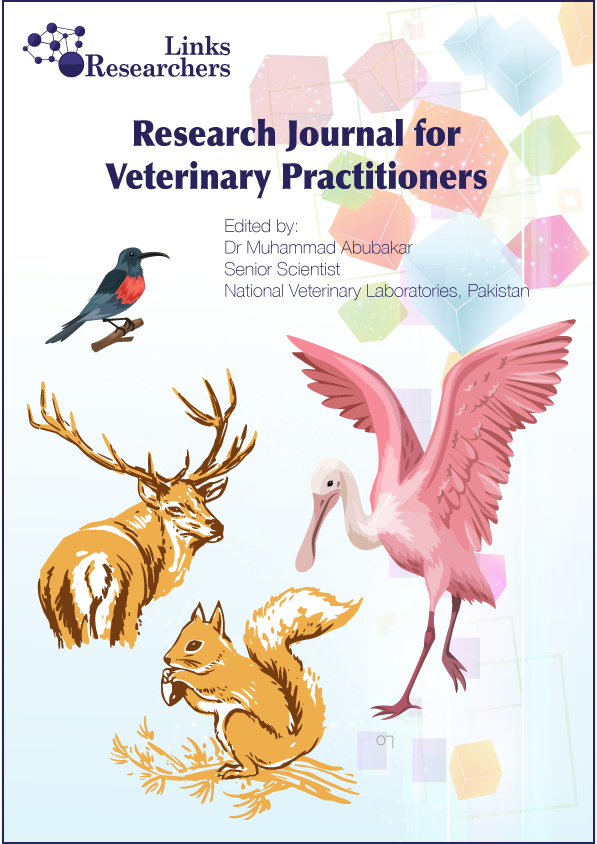Effectiveness of Fluralaner in Ticks Infesting Horses (Equus caballus)
Short Communication
Effectiveness of Fluralaner in Ticks Infesting Horses (Equus caballus)
Camilo Romero Núñez1, Galia Sheinberg Waisburd2, Alberto Martin Cordero3, Rafael Heredia Cárdenas1, Laura Miranda Contreras1, Ariadna Flores Ortega4, Linda Guiliana Bautista Gómez5
1Dermavet Hospital Veterinario, José de la Luz Blanco, Mz. 187, Lt. 33, Col. Santa Martha Acatitla, Ciudad de México; 2Dermatología Especializada, Centro Veterinario México, Calle Cincinnati #22, Benito Juárez, Cd de los Deportes, 03710 Ciudad de México, México; 3VETDERM: Dermatología Veterinaria Especializada, Argentina No. 690, Colonia Moderna, Guadalajara, 44190 Jalisco México; 4Consejo Nacional de Humanidades, Ciencias y Tecnologías CONAHCYT. Estancia Postdoctoral por México. Universidad Autónoma del Estado de México. Centro Universitario UAEM-Amecameca., Km. 2.5 Carretera Amecameca-Ayapango, 56900, Amecameca de Juárez, Estado de México, México; 5Centro Universitario UAEM-Amecameca., Km. 2.5 Carretera Amecameca-Ayapango, 56900, Amecameca de Juárez, Estado de México, México.
Abstract | In horses, ticks cause a wide range of health and welfare problems; they can cause direct damage such as skin lesions and anemia and indirect problems spreading several infectious diseases, such as papulonodular dermatoses, Lyme disease, and viral encephalitis, or cause parasite-induced abortion. Because of the risk, they represent measures to control their spread, such as restricting global trade and sporting events. Therefore, the efficacy of fluralaner was evaluated against ticks in horses. Horses were treated with fluralaner 25 mg/kg. Most of the ticks were found on the ears (55.63%), the head (23.23%), and the rest of the body (21.12%). Fluralaner appears to provide effective control of ticks for at least 90 days. In this study, with the administration of fluralaner from day 14 after the application, 94% efficacy was observed, and from day 30 until day 90, in addition to ensuring distribution throughout the body without causing discomfort or adverse effects to the horse.
Keywords | Amblyomma, Efficacy, Fluralaner, Horses, Rhipicephalus, Ticks
Received | August 30, 2023; Accepted | May 22, 2024; Published | June 01, 2024
*Correspondence | Ariadna Flores Ortega, Consejo Nacional de Humanidades, Ciencias y Tecnologías CONAHCYT. Estancia Postdoctoral por México. Centro Universitario UAEM Amecameca, Universidad Autónoma del Estado de México, Estado de México, México; Email: ariadnafloresortega@gmail.com
Citation | Nunez CR, Waisburd GS, Cordero AM, Cardenas RH, Contreras LM, Ortega AF, Gomez LGB (2024). Effectiveness of fluralaner in ticks infesting horses (Equus caballus). Res J. Vet. Pract. 12(2): 22-24.
DOI | http://dx.doi.org/10.17582/journal.rjvp/2024/12.2.22.24
ISSN | 2308-2798

Copyright: 2024 by the authors. Licensee ResearchersLinks Ltd, England, UK.
This article is an open access article distributed under the terms and conditions of the Creative Commons Attribution (CC BY) license (https://creativecommons.org/licenses/by/4.0/).
Introduction
According to a rough estimate, 90 million horses worldwide are used for agricultural work and sport (Cunha et al., 2007). In horses, ticks cause a wide range of health and welfare problems; they can cause direct damage such as skin lesions and anemia and indirect problems spreading several infectious diseases, such as papulonodular dermatoses, Lyme disease, and viral encephalitis, or cause parasite-induced abortion. Because of the risk, they represent measures to control their spread, such as restricting global trade and sporting events (Cunha et al., 2007; Gharbi et al., 2018; Kamran et al., 2021). The most frequent tick-borne pathogens are Babesia caballi, Theileria equi, Borrelia burgdorferi and Anaplasma phagocytophilum (Gharbi et al., 2018). Visible clinical signs associated with the tick have been reported as pruritus, thickened coat, and hemorrhagic areas, in addition to pruritic exanthema, papules, and spots of alopecia with small, ulcerated lesions (Kamran et al., 2020). Unfortunately, the options available for tick control in equines are limited, require frequent reapplications, and may have safety issues, so tick infestations will likely remain a challenge for horse owners (Seo et al., 2020). The objective of this study was to evaluate the efficacy of a fluralaner (Bravecto®, MSD, USA) against ticks in horses.
Materials and methods
Animals
Five females horses and five males were used in the trial, with an average age of 12 (± 5) years, weighing 432 (± 12) kg. Selected animals were evaluated for the presence of ticks and did not receive any acaricides 30 days before the trial.
Treatment
All horses were treated with fluralaner 25 mg/kg. Ticks were counted and identified morphologically on the day (D)1, D7, D14, D30, D45, D60, and D90. No other treatment was administered during the study.
Statistical methods
Data were analyzed using the Wilcoxon matched pairs test with an alpha of 0.05 for comparison between posttreatment measurements.
Results
Two tick species were identified: Amblyomma cajennense and Rhipicephalus microplus. The most significant number of ticks were found in the ears (55.63%), followed by the head (23.23%) and the rest of the body (21.12%). On D7, tick numbers were significantly reduced by 78.67% (P = 0.0001). On D14, there was a continued decrease in tick numbers compared to initial counts; tick numbers were reduced by 94% (P = 0.0001). By D30, tick numbers were reduced by 99.33% (P = 0.006). From D30 to D90, no ticks were found showing the sustained activity of fluralaner over time. No adverse effects were observed during the clinical trial.
Discussion
Ticks infest horses throughout the year, even in the winter months, and can be found in various regions on horses. So as with small animals, horses can benefit from year-round tick control (Seo et al., 2020). Results from a survey revealed that the use of acaricides is the most common method (76.52%) for control of tick infestation in horses and that the most commonly used acaricide is ivermectin (47% of horse caretakers), while fipronil is the second most used acaricide (45%) (Sundstrom et al., 2021).
Cypermethrin at a concentration of 0.015% and cypermethrin (Volpato et al., 2013), chlorpyrifos, and citronellal together have also been used (Kamran et al., 2020). Besides not being effective against A. cajennense ticks, Amitraz should not be used in horses as it is poisonous to these animals. Acaricide resistance has been reported in several tick species against almost all classes of acaricides, including macrolactones (Cunha et al., 2007). A horse study suggested that acaricide resistance exists against fipronil and ivermectin, as 100 % efficacy was not achieved for any acaricide even after 36 days of treatment (Cunha et al., 2007). In addition, A. cajennense species require higher acaricide formulations concentrations (Volpato et al., 2007). Horse keepers have adopted various methods, such as dunk tank, footbaths, portable hand spraying, and the direct pour-on method for acaricide application (Cunha et al., 2007). However, topically applied acaricide treatments may have access difficulties (nasal and ear diverticula), generate discomfort and repulsion in animals (Volpato et al., 2007). In this study, with the administration of fluralaner from day 14 after the application, 94% efficacy was observed, and from day 30 until day 90, no ticks were found present in the horses, in addition to ensuring distribution throughout the body without causing discomfort or adverse effects to the horse.
Conclusion
Based on these data, fluralaner effectively controls A. cajennense and R. microplus ticks for ≥90 days.
Conflict of interests
No authors have any conflicts of interest.
authors contribution
Camilo RM; Galia SW; Alberto MC : Investigation; Project administration; Supervision; Validation; Writing-review & editing;
Laura MC: Conceptualization; Resources; Supervision; Validation.
Rafael HC: Conceptualization; Project administration;
Supervision; Writing-original draft; Validation.
Ariadna FO: Conceptualization; Methodology; Writing-original draft; Validation.
References
Cunha AP, Da Bello ACP, De P Leite RC, Cândido AC, RibeiroIII Leite, V. de Freitas CM, Bastianetto I E, OliveiraII PR. (2007). Efeito do controle estratégico de Amblyomma cajennense (Fabricius, 1787) (acari: ixodidae) sobre a população de Anocentor nitens (Neumann, 1897) (acari: ixodidae) em eqüinos. Rev. Bras. Parasitol. Vet. 16: 215–219. https://doi.org/10.1590/S1984-29612007000400007
Gharbi M, Driss,i G, Darghouth MA (2018). Population dynamics of ticks infesting horses in north-west Tunisia. Rev. Sci. Tech. Off. Int. Epiz. 37: 837-841. https://doi.org/10.20506/rst.37.3.2890
Kamran K, Ali A, Villagra CA, Bazai ZA, Iqbal Asim, Sohail MS (2020). Hyalomma anatolicum resistance against ivermectin and fipronil is associated with indiscriminate use of acaricides in southwestern Balochistan, Pakistan. Parasitol. Res.120: 15–25. https://doi.org/10.1007/s00436-020-06981-0
Kamran K, Ali A, Villagra C, Siddiqui S, Alouffi AS, Iqbal A. (2021). A cross‐sectional study of hard ticks (acari: ixodidae) on horse farms to assess the risk factors associated with tick‐borne diseases. Zoon. Pub. Health. 68: 247–262. https://doi.org/10.1111/zph.12809
Seo MG, Kwon OD, Kwak D (2020). Diversity and genotypic analysis of tick‐borne pathogens carried by ticks infesting horses in Korea. Med. Vet. Entomol. 35: 213-218. https://doi.org/10.1111/mve.12483
Sundstrom KD, Lineberry MW, Grant AN, Duncan KT, Lentile MM, Little SE (2021). Equine attachment site preferences and seasonality of common North American ticks: Amblyomma americanum, Dermacentor albipictus, and Ixodes scapularis. Parasit. Vectors. 14:404. https://doi.org/10.1186/s13071-021-04927-8
Volpato A, Agostini M, Tonin AA, Tonin AA, Schafer AS (2013). High infestation by Rhipicephalus (Boophilus) microplus in a mare: a rare case report. Comp. Clin. Pathol. 22: 1263-1265. https://doi.org/10.1007/s00580-013-1787-4
Zovko KM, Kremer D, Karlović K, Kosalec I (2010). Evaluation of antioxidant activities and phenolic content of Berberis vulgaris L. and Berberis croatica Horvat. Food. Chem. Toxic. 48(8-9): 2176 – 2180. https://doi.org/10.1016/j.fct.2010.05.025
To share on other social networks, click on any share button. What are these?






